Core-collapse supernovae
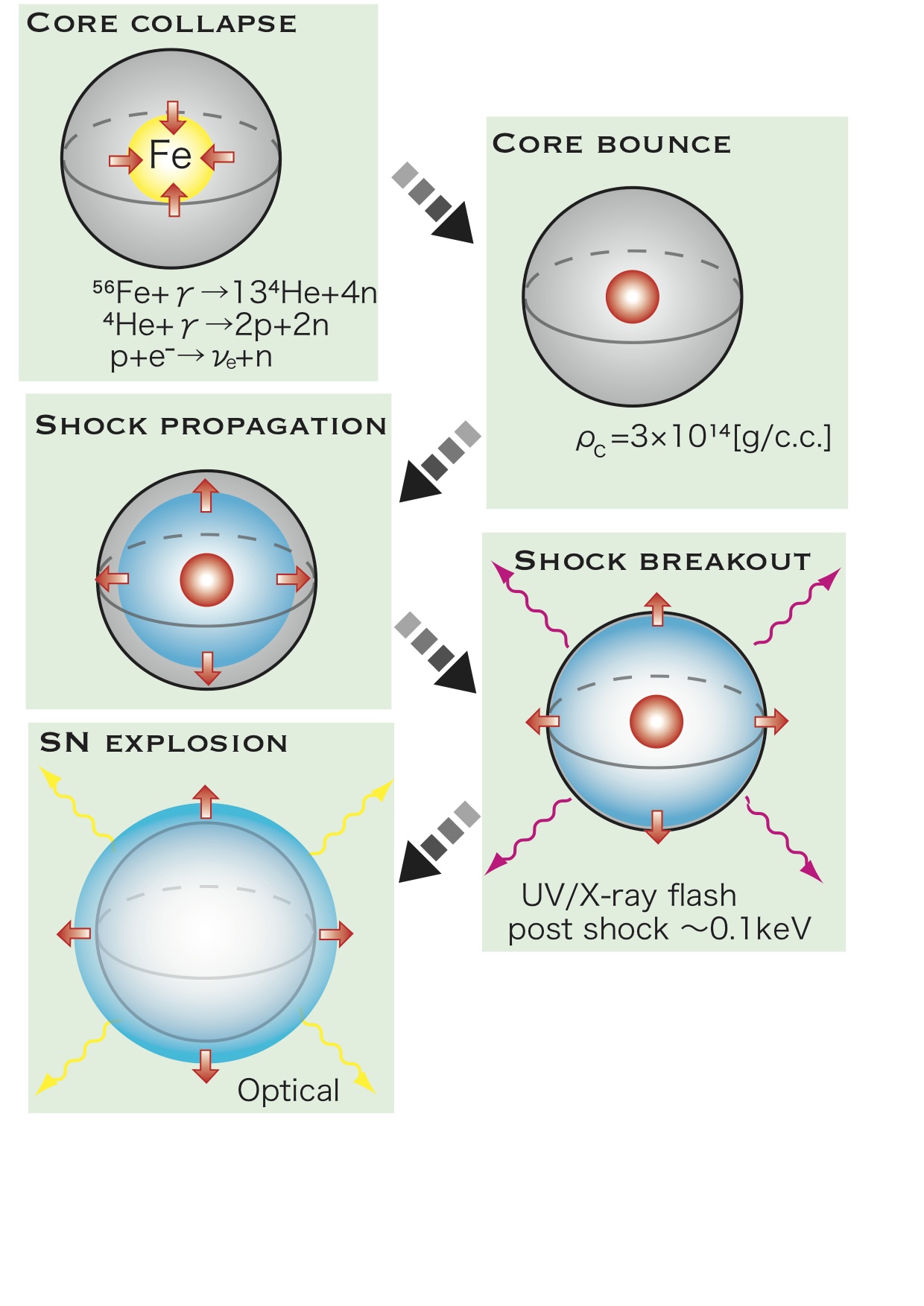 Massive stars with their initial masses heavier than 8-10 solar mass end their lives when their iron cores collapse by their own gravity.
The terminal explosion produces a compact remnant (a neutron star or a black hole) and the liberated gravitational energy give rise to neutrino emission.
At the same time, a fraction of the liberated energy is used to expel the stellar mantle, giving rise to a core-collapse supernova (CCSN) explosion.
Observationary, the massive star's deaths are found as a bright point source emitting visible lights.
The final lights from massive stars tell us abount various information on their final fates, star-forming activity having produced massive stars, and so on.
Currently working transient survey programs, such as, the Zwicky Transient Facility, Pan-STARRS, and Hyper Sprime-Cam on Subaru telescope, are finding interesting transients related to massive star's deaths.
In the near future, the planned successors, such as, Large Synoptic Survey Telescope, will further extend the horizon.
For better understanding of massive stars, their evolutions, and the compact remnent, theoretical investigations on how they explode, how the explosions look like, and how surrounding materials are affected, are inevitable.
Massive stars with their initial masses heavier than 8-10 solar mass end their lives when their iron cores collapse by their own gravity.
The terminal explosion produces a compact remnant (a neutron star or a black hole) and the liberated gravitational energy give rise to neutrino emission.
At the same time, a fraction of the liberated energy is used to expel the stellar mantle, giving rise to a core-collapse supernova (CCSN) explosion.
Observationary, the massive star's deaths are found as a bright point source emitting visible lights.
The final lights from massive stars tell us abount various information on their final fates, star-forming activity having produced massive stars, and so on.
Currently working transient survey programs, such as, the Zwicky Transient Facility, Pan-STARRS, and Hyper Sprime-Cam on Subaru telescope, are finding interesting transients related to massive star's deaths.
In the near future, the planned successors, such as, Large Synoptic Survey Telescope, will further extend the horizon.
For better understanding of massive stars, their evolutions, and the compact remnent, theoretical investigations on how they explode, how the explosions look like, and how surrounding materials are affected, are inevitable.
Central engine model for extra-ordinary supernovae
One of the successes of the above modern transient survey programs is the discovery of a special class of SNe characterized by their extreme brightness. They are now called superluminous supernovae. Their extreme brightness makes it possible for us to find superluminous supernovae even in distant galaxies. However, the problem is that the energy source responsible for their brith thermal emission has yet to be specified. One of the plausible scenarios is the central engine scenario, in which the supernova produce a central compact object (highly-spinning magnetized neutron star, black hole accretion disk, or whatever) and it deposits an additional energy into the supernova ejecta. Because of the energy injection from the central energy source, the supernova ejecta are energized and give rise to bright thermal emission. I'm currently working on the numerical computation by using parallel supercomputers to reveal what would happen in this system and find observational signature distinguishing the central engine-powered SNe from other scenarios.
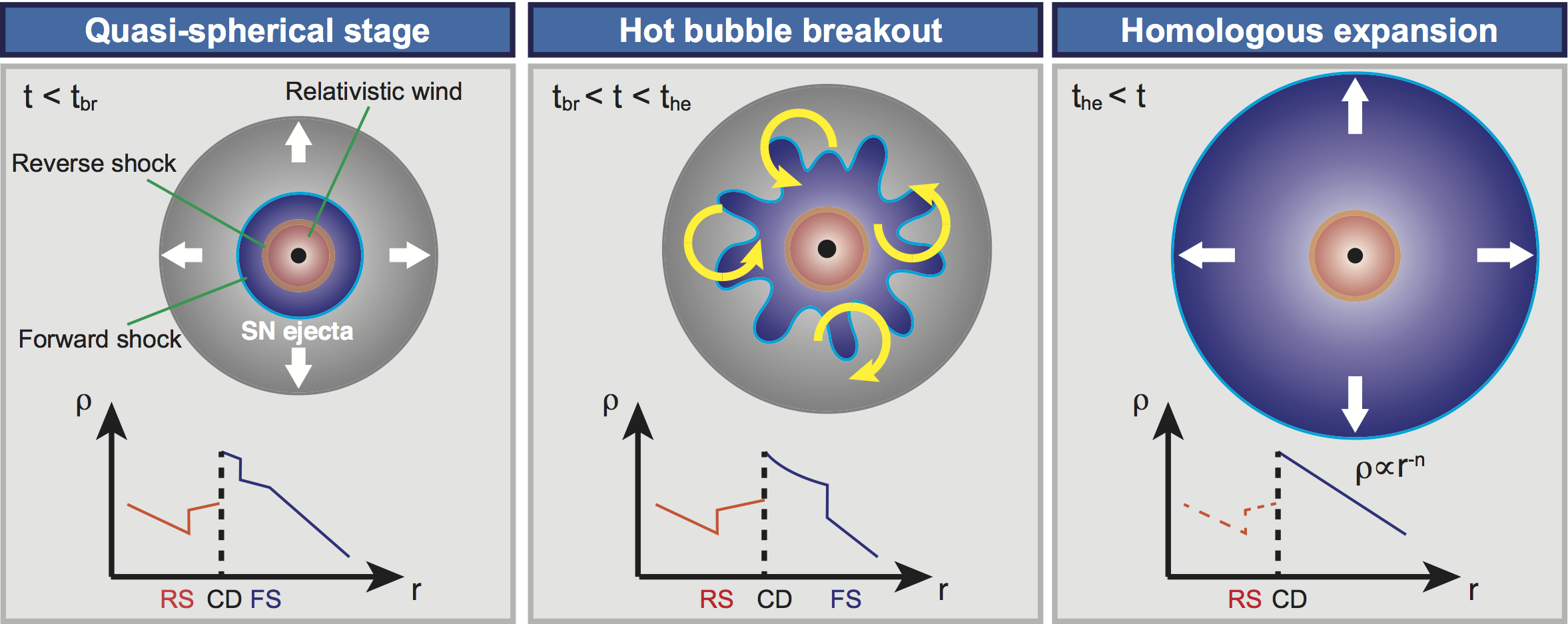
Interacting supernovae
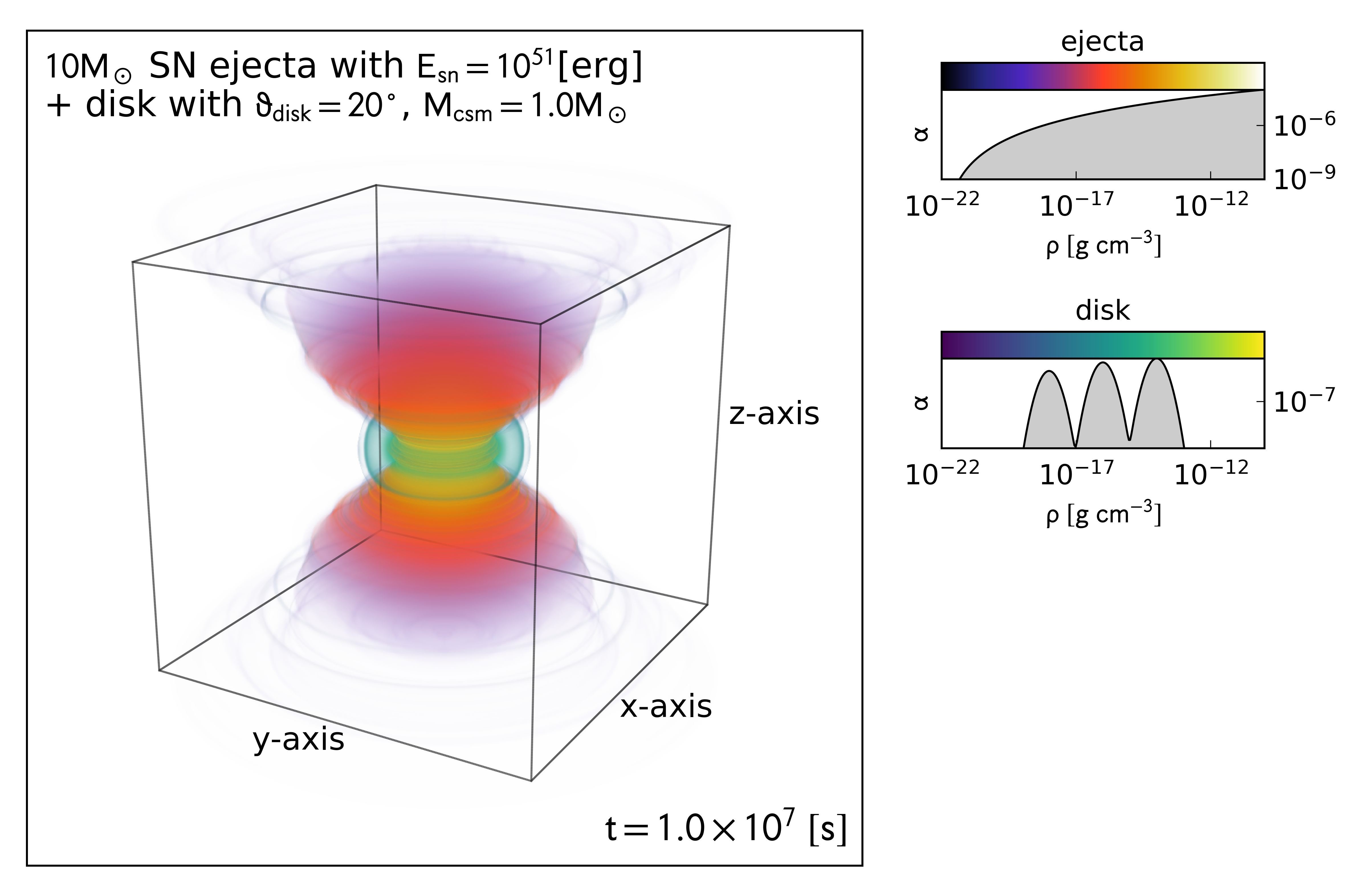
A specific class of CCSNe show an evidence of a dense gas surrounding the progenitor star, i.e., the so-called circum-stellar medium (CSM). The presence of CSMs could be infered by a characteristic spectral feature, narrow absorption/emission lines superposed on broad P-cygni lines, which is usually observed in sueprnova spectra. Narrow spectral lines indicate a slowly moving (~10-100km/s) gas is ahead of fast SN ejecta traveling at ~10,000km/s. SNe with interaction features are called interacting SNe or interaction-powered SNe and comprise a sub-class of SNe. In terms of spectroscopic classification of SNe, they are classified into type IIn and Ibn SNe, depending on the presence/absence of hydrogen and helium spectral features. Even for type Ia SNe, which are thermonuclear explosions of white dwarfs, there are some events exhibiting interaction feature and they are called type Ia-CSM.
One of the impotant aspects of the ejecta-CSM interaction is that the collision between the two flow with different velocities can dissipated the kinetic energy of the flows as thereby serves as a power source for bright thermal emission. In fact, some superluminous SNe, such as SN 2006gy, show spectral features indincating the presense of a massive CSM. Such massive CSMs in the vicinity of exploding stars should have been produced immediately before the stellar explosion. However, the problem is that we currently do no know how and when exactly such massive CSMs are produced. There are some proposed mechanisms (binary interaction, commomn envelope, wave-driven eruptive mass-loss, and so on) for such extensive mass-loss processes prior to stellar explosions.
Supernova shock breakout
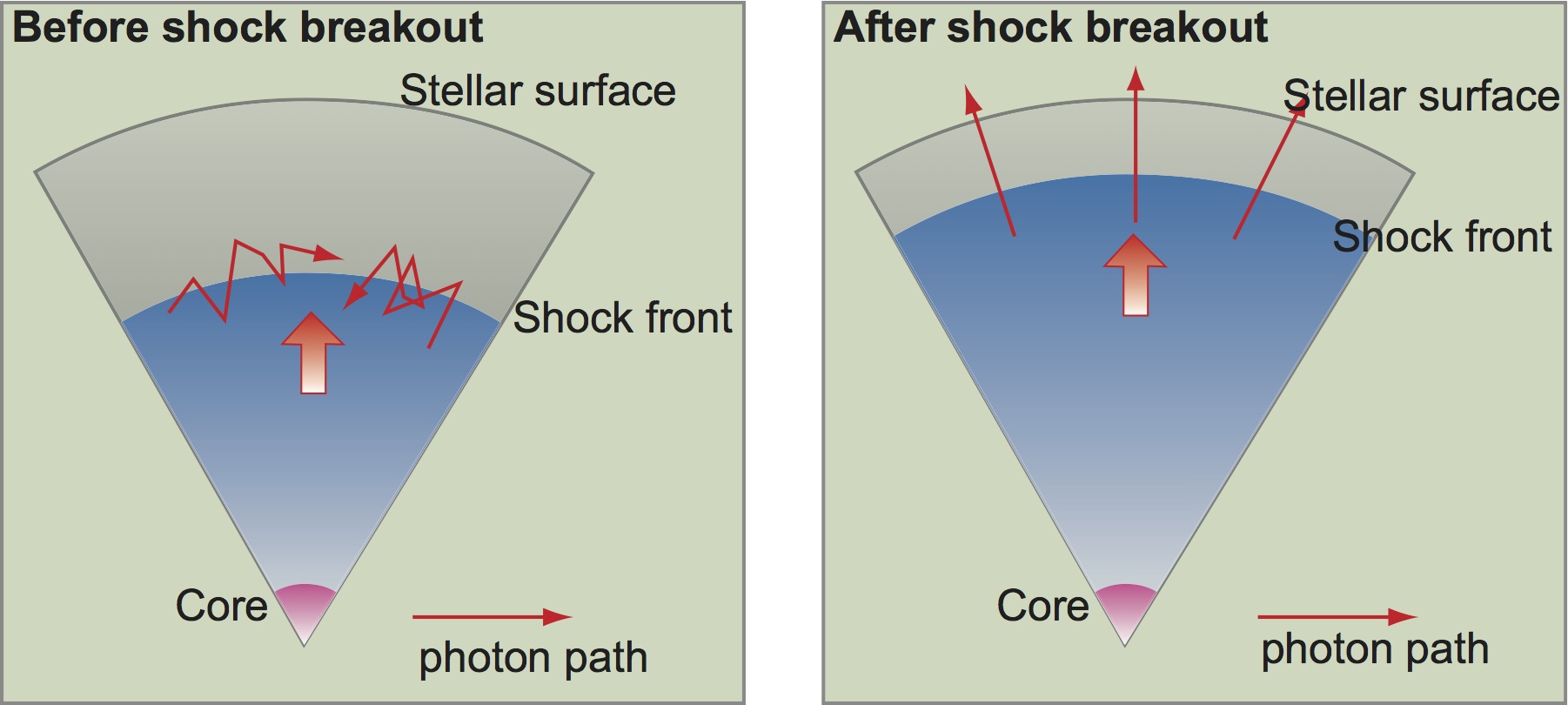 A CCSN explosion is initiated by almost instantaneous (within ~1sec) deposition of the explosion energy at the core of a massive star.
Neutrinos emitted by the proto-neutron star, which forms as a result of the iron-core collapse, are responsible for the energy deposition, although how exactly it happens is still debated.
The energy deposition leads to the formation of a strong shock wave propagating in the stellar interior, which eventually emerges from the stellar surface.
This shock emergeince is called supernova shock breakout, accompanied by the initial electromagnetic radiation from a CCSN.
The initial lights from a CCSN is much brighter than the subsequent thermal emission powered by the radioactive decay of nickel.
I perform numerical simulations based on radiation-hydrodynamics to reveal how bright this phenomena could be.
A CCSN explosion is initiated by almost instantaneous (within ~1sec) deposition of the explosion energy at the core of a massive star.
Neutrinos emitted by the proto-neutron star, which forms as a result of the iron-core collapse, are responsible for the energy deposition, although how exactly it happens is still debated.
The energy deposition leads to the formation of a strong shock wave propagating in the stellar interior, which eventually emerges from the stellar surface.
This shock emergeince is called supernova shock breakout, accompanied by the initial electromagnetic radiation from a CCSN.
The initial lights from a CCSN is much brighter than the subsequent thermal emission powered by the radioactive decay of nickel.
I perform numerical simulations based on radiation-hydrodynamics to reveal how bright this phenomena could be.
Gamma-ray bursts
Gamma-ray bursts (GRBs) are enigmatic bursts of gamma-rays found on the celestial sphere. Space gamma-ray and X-ray observatories routinely find these spontaneous bursts at a rate of 1 event per day. Currently, they are thought to be violent explosions happening in distant galaxies. They are classified into two broad categories, long- and short-GRBs, according to the duration of the prompt gamma-ray emission. The most plausible scenarios for long- and short-duration events are massive star's death and the coalescense of a neutron star-neutron star binary. Highly energetic photons can be produced by ultra-relativistic jets driven by these violent events. However, there are still remaining promlems, such as, what is the mechanism driving the jet and how gamma-rays are created.low-luminosity GRBs
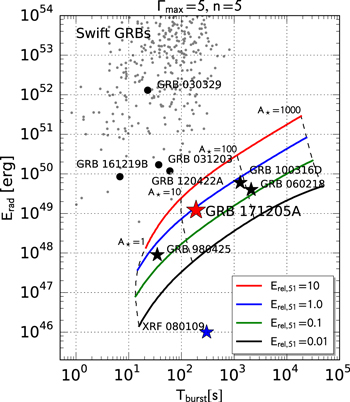 GRBs with less luminous gamma-ray emission are classified as low-luminosity GRBs (or llGRBs, for short).
LLGRBs are considered to be a distinct population from GRBs we find at cosmological distances.
Their less luminous gamma-ray emission do not allow us to detect them at cosmological distances and therefore we only detect nearby events with a limited sample size.
However, they are though to be more abundant than cosmological GRBs on a volumetric basis.
We have been developing a theoretical emission model for llGRBs to reveal the origin of their gamma-ray emission followed by afterglows from radio to high-energy gamma-rays.
GRBs with less luminous gamma-ray emission are classified as low-luminosity GRBs (or llGRBs, for short).
LLGRBs are considered to be a distinct population from GRBs we find at cosmological distances.
Their less luminous gamma-ray emission do not allow us to detect them at cosmological distances and therefore we only detect nearby events with a limited sample size.
However, they are though to be more abundant than cosmological GRBs on a volumetric basis.
We have been developing a theoretical emission model for llGRBs to reveal the origin of their gamma-ray emission followed by afterglows from radio to high-energy gamma-rays.
Others
chemical evolution of the Galaxy
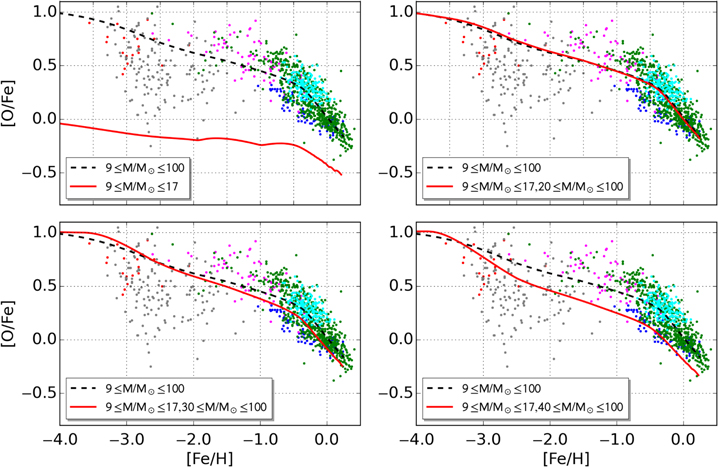 One of the important roles of CCSNe is to provide the inter-stellar gas with heavy elements (heavier than H, He) having been synthesized in massive stars on the course of their evolution.
As a result, star-forming galaxies eventually enrich their metal content.
Observationally, stars' surface chemical composition tell us about the inter-stellar gas from which they form.
For example, the observed oxygen and iron abundance (with respect to to hydrogen) show clear relation, which keep the history of the chemical enrichment processes.
This means that we can contrain what processes, or what types of CCSNe, SNIa, or whatever, are responsible for the enrichment history of specific elements.
One of the important roles of CCSNe is to provide the inter-stellar gas with heavy elements (heavier than H, He) having been synthesized in massive stars on the course of their evolution.
As a result, star-forming galaxies eventually enrich their metal content.
Observationally, stars' surface chemical composition tell us about the inter-stellar gas from which they form.
For example, the observed oxygen and iron abundance (with respect to to hydrogen) show clear relation, which keep the history of the chemical enrichment processes.
This means that we can contrain what processes, or what types of CCSNe, SNIa, or whatever, are responsible for the enrichment history of specific elements.


